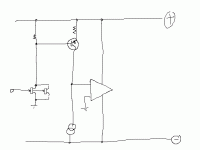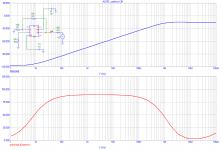scott wurcer said:You won't find a complement for the BF862 it was designed specifically for AM car radios in the RF section I think, go figure.
Yes I know that; that's why I asked. What I'm really wondering is what kind of alternative topology SYN08 has in mind with this device. Incidentally, this looks like a really nice part for my spectrum analyser IF stages. Thanks!
Cheers,
Glen
scott wurcer said:
Gee, I hope this is from the old PMI 🙂 They just left out the liquid helium cooling on that 100 Ohm resistor.
It's 0.5nV with the 100 ohms shorted. 3 pairs MAT-03 gets you 0.32nV, apparantly.
Wot is PMI????
Cheers,
Glen
Precision Monolythic Inc., the ones who did the MAT02/MAT03, SSM devices, + OP27 etc. before Analog-D swallowed them.
john curl said:A good point has been brought up. Can you imagine how much xover distortion the 797 will generate (open loop) with this sort of load? WOW! Then calculate the PIM distortion because of the nonlinear input stage that has to work to cover this over.
There's nothing to worry about John. The opamp has to deliver worst case 20mA peak and that's at 20KHz for a total output of the HPS3.0 of 22Vpeak (the clipping limit). That's a current value that lots of decent low noise opamps (in particular those DSL drivers) can deliver without any problems. Again, we are not talking here about opamps available 25 years ago.
G.Kleinschmidt said:It's 0.5nV with the 100 ohms shorted. 3 pairs MAT-03 gets you 0.32nV, apparantly.
Absolutely. Together with about 70uA current in the cartridge. Unless you chose to use a large input film cap that would also act as a great antenna in picking up noise.
syn08 said:
Absolutely. Together with about 70uA current in the cartridge. Unless you chose to use a large input film cap that would also act as a great antenna in picking up noise.
Use enough of selected MAT-02 complements in a symmetrical topology to cancel out the base current 😀
G.Kleinschmidt said:Use enough of selected MAT-02 complements in a symmetrical topology to cancel out the base current 😀
Yes. And a thermostat to avoid drifts.
Actually something like the THAT340 could be probably successfully used - but I don't think it's worth the trouble (or anywhere cost effective).
With 317/337 plus parallel regulators the PSRR is 100dB and noise pretty much negligible anyway. Jung regulators with force/sense will do even better, but they are really not worth the trouble here. I'll reconsider them when attempting under 0.2nV/rtHz.
syn08 said:
Yes. And a thermostat to avoid drifts.
Actually something like the THAT340 could be probably successfully used - but I don't think it's worth the trouble (or anywhere cost effective).
With 317/337 plus parallel regulators the PSRR is 100dB and noise pretty much negligible anyway. Jung regulators with force/sense will do even better, but they are really not worth the trouble here. I'll reconsider them when attempting under 0.2nV/rtHz.
How much did ~200 jfets for sorting cost you? 😀
Back to non complementary, single-ended (BF862) input stages:
As for better PSRR, why not aim to actually improve the input stage performance too?
A big fat AC coupling cap from a drain resistor referenced to supply rai....BARF!
Maybe do this (just be carefull how you frequency compensate it):
Attachments
G.Kleinschmidt said:
How much did ~200 jfets for sorting cost you? 😀
Back to non complementary, single-ended (BF862) input stages:
As for better PSRR, why not aim to actually improve the input stage performance too?
A big fat AC coupling cap from a drain resistor referenced to supply rai....BARF!
Maybe do this (just be carefull how you frequency compensate it):
$80 😀
You certainly don't like JFETs, arent you 😀
That option is in the cards; but I'm thinking more and more about cooling the thing. A 1x1 inch Peltier device is cooling 10W at 70 degrees centigrades under the ambient and costs $20. Have to figure out what to do with the heat and condensation, though... Soo this thing is going to look like a power amp, with finned heatsinks, etc...
john curl said:Have they sent out the preliminary data yet? I haven't gotten to my mailbox in weeks. If so, is there ANYTHING that might be useful from a linear audio point of view?
Hi John,
You'll love this. There is at least one paper on a Class-D audio amplifier chip.
Lot's of Green stuff on energy scavenging and energy harvesting.
Cheers,
Bob
Bob Cordell said:
Lot's of Green stuff
Green is the new Digital ( marketing slogan ) ...
An externally hosted image should be here but it was not working when we last tested it.
Bob Cordell said:
There is at least one paper on a Class-D audio amplifier chip.
Lot's of Green stuff on energy scavenging and energy harvesting.
There is more than one paper on a Class-D audio amplifier chips.
Papers are one thing, the way they sound is another thing.
There isn't free lunch.
Greenie
Now that my 384.5 cui daily driver project is completed and my Landrover and supercharged 260Z coupe rebuild should be done in a year or two I've decided on the next (and final) car project.
Will be looking for a straight 4 door HQ Holden shell - Big engine bay and a Chevy 502 fits right in on avaliable 350 engine mounts.
I was thinking cherry red for the shell, but maybe a nice bright green would look good too.
Hmmmmmm.................woops, O/T....
Now that my 384.5 cui daily driver project is completed and my Landrover and supercharged 260Z coupe rebuild should be done in a year or two I've decided on the next (and final) car project.
Will be looking for a straight 4 door HQ Holden shell - Big engine bay and a Chevy 502 fits right in on avaliable 350 engine mounts.
I was thinking cherry red for the shell, but maybe a nice bright green would look good too.
Hmmmmmm.................woops, O/T....
So John's previous statement raises a question, if you are using a class A amp that generates a lot of heat, but you use the heat productively, does that make it more efficient?!😀 😉
john curl said:The 1 Hz bandwidth should not bother you. It is easy to average over a much larger bandwidth by multiplying over the square root of the larger bandwidth.
For example, a 10,000Hz bandwidth looks like 100 times more noise than a 1 Hz bandwidth. IF everything is normalized to 1 Hz, it is easy to do piecemeal approximations, because the noise may be worse at the end of the bands, and have to be totaled separately to get an accurate evaluation of what you are going to get just from the data sheet.
Got It!

john curl said:Anyone have a Spice simulation of the AD797? Let's load it down and see!
Good point. I will show a few.
Attachments
- Status
- Not open for further replies.
- Home
- Amplifiers
- Solid State
- John Curl's Blowtorch preamplifier


